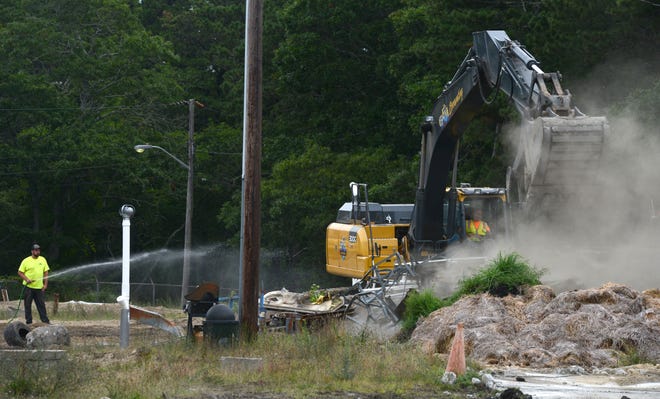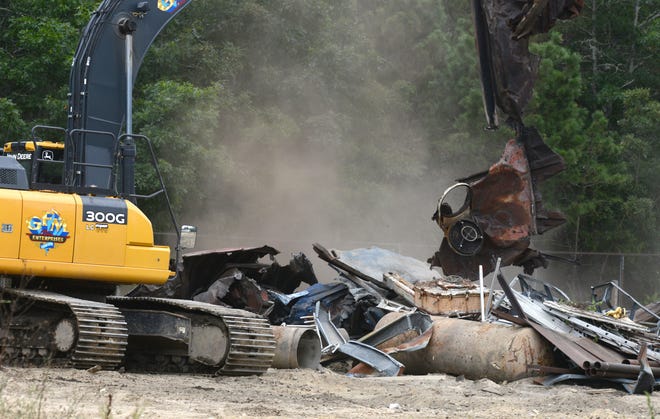'Sink this project': Emails show concern of environmental review on machine-gun range
Jessica Hill Cape Cod Times
Published Sep 8, 2021
DENNIS — The Association to Preserve Cape Cod is calling on Gov. Charlie Baker to shelve a proposed machine-gun range on the Upper Cape after public records showed the military’s concerns over growing environmental scrutiny.
The nonprofit environmental organization received emails after a public records request made to the Massachusetts National Guard that included emails from Joint Base Cape Cod Executive Director Brigadier General Christopher Faux to office staff of U.S. Rep. William Keating, D-Mass.
In one email from March 26, Faux said the military has heard from multiple agencies and has seen numerous news articles about Keating, along with Sens. Elizabeth Warren and Edward Markey, requesting further review of the project from the National Environmental Policy Act in the form of an environmental impact statement.
“If that is the case, we will most likely lose the project and its funding and will have wasted ten years of work,” Faux wrote.
Faux declined to comment, saying in an email Wednesday morning that per protocol, he forwarded the records request to the public affairs office, which has not responded.

The multipurpose machine-gun range, planned for the site of the base’s existing KD, or “known distance” range, would sit above the Upper Cape Water Supply Reserve and would cost $11.5 million. The range would be used for military training with different weapons, including machine guns, 12-gauge shotguns, grenade launchers and pistols. The proposal calls for clearing 170 acres of forest and disturbing about 199 acres of land.
The National Guard Bureau approved the project April 30 in an environmental study that found no significant impacts from the gun range, but many residents and organizations have expressed concern about the impact the machine-gun range would have on the environment, particularly the Cape’s water supply.
Previous coverage
- Mashpee Wampanoag Tribe opposes machine gun range project at Joint Base Cape Cod
- Proposed machine gun range on Upper Cape base gets nod from advisory group
- Concerns remain over proposed machine-gun range at Joint Base Cape Cod
- Photo Gallery: Residents rally against proposed machine gun range
The Environmental Protection Agency will review the proposed machine-gun range and the potential risks it may pose to public drinking water, Markey, Warren and Keating announced in August.
Faux wrote in an email to Keating’s office that the Massachusetts National Guard used a fact-based assessment that meticulously followed the NEPA process.
“Comparatively, our adversaries who have yet to provide a single fact that refutes our analysis, will have set a precedent and a deadly blow to the US Military and the safety and security of this great nation based solely on their ‘feeling’ that additional study is required,” Faux wrote.
Andrew Gottlieb, the executive director of the Association to Preserve Cape Cod, said in a Tuesday statement that the emails reveal both the National Guard’s worry about submitting the machine gun-range project to a thorough environmental review but also demonstrate a “complete disregard of the public’s legitimate concerns about the potential environmental impacts of the project.”
Association to Preserve Cape Cod filed public records requests
The Association to Preserve Cape Cod decided to file the public records requests after Faux threatened to stop supporting Cape Cod businesses if they did not support the machine-gun range.
“We were concerned that similar threats may have been made to our elected officials, those who may have influence over the future of the proposed project,” Gottlieb said in the statement.
The emails were turned over to the Association to Preserve Cape Cod after it filed an appeal to the Massachusetts state secretary’s office when the Guard repeatedly withheld the requested information.
Association to Preserve Cape Cod: Public records sought from Guard general
“I can now see why the Guard would not want the public to see these emails,” Gottlieb said in the statement.
In one email to Keating’s office staff, Faux referenced a Cape Cod Times article reporting on Keating’s call to take a closer look at the machine-gun range. He said he understands that Keating must work with every constituent and support his reelection activities, but those who oppose the machine gun range make up less than 0.5% of the Cape’s population, who he claims have provided a “strong campaign of misinformation.”
Joint Base Cape Cod: Federal pols weigh in on proposed machine-gun range
“We have provided these folks with EVERY possible piece of information they could need to make an informed decision,” Faux wrote in the March 24 email, “which they obviously do not care to make.”
He said in a March 24 email to Keating's staff that the project would have an overall positive impact to the environment, with copper bullets that would not affect groundwater, mitigation to improve the habitat and eventually sequester carbon, but that “falls on deaf ears in the small fraction of citizens that represent the activists.”
“Honestly, just the phrase ‘further NEPA review or EIS (Environmental Impact Statement) coming from the (congressional) delegation will sink this project and dramatically impact the MA National Guard,” he said in the email.
He added that the National Guard can meet the desires of Keating and the rest of the delegation in regard to "appeasing" those in opposition by providing a deeper dive into the impacts of the project without adding NEPA action.
On April 12, Faux sent another email to Keating’s office about an April 9 letter that Keating, Warren and Markey sent to Lt. Gen. Jon Jensen, director of the Army National Guard, that expressed further concerns about the machine-gun range.
“It’s pretty obvious that you have deliberately deceived me and my colleagues and created a false sense of trust,” he said in the email. “I am still shocked that the delegation would abandon the Guard based on comments from a small group of activists that manipulate facts to perpetuate their own anti-military agendas.”
The Association to Preserve Cape Cod says the project has not been managed legitimately and with fair consideration of public input.
“The governor has no other choice if he wishes to restore faith in the integrity of the public process under his administration,” Gottlieb said in the statement.
Chatham calls special town meeting to deal with low water levels and PFAS in drinking water supply
CHATHAM — With the town's drinking water system showing signs of stress from seasonal demand and a continuing drought, Chatham is also struggling with relatively high levels of PFAS in two wells, making it harder to handle demand.
At their meeting Tuesday night, Chatham Select Board members voted to open a new well (Well No. 4), pending approval from the state Department of Environmental Protection. The public water system's contracted operator Weston & Sampson has been installing equipment and doing tests to prepare it for pumping.
The board also unanimously approved holding a special town meeting at 9:30 a.m. Oct. 23 to ask for $4.5 million to open two new wells (No. 10 and 11) and money to design PFAS treatment facility for two wells (No. 5 and 8). The $4.5 million will include design work to incorporate PFAS and iron and manganese treatment if required in the future.
Both articles are funded from water system money and will not require a separate ballot vote for a Proposition 2½ debt exclusion because they don't impact property taxes.
The select board voted unanimously to endorse both articles.
Thoseactions came tempered with caution that the Lower Cape, and particularly Chatham, need a rainy/snowy winter to rebuild their water supply.
Chatham Natural Resources Director Robert Duncanson said monitoring wells along the Chatham/Brewster line continue to show a downward trend in water levels despite a recent soaking rain that was still less than half what other parts of the Cape experienced from the remnants of Hurricane Ida. The U.S. Drought Monitor shows Brewster, Chatham and Orleans classified as in a severe drought, one step below extreme drought, in its most recent data last week.
"It's something we worry about if it continues into the fall," Duncanson said. "With no huge snowmelt (this winter), next year could be worse."
Even though water use was down by 14% in August compared to last year — thanks in part to water restrictions in place since the spring after a dry winter — the town's water division became concerned that three drinking water wells were close to mandatory shutdown levels due to low groundwater. The water division said reopening Well No. 4, which the select board approved Tuesday, was critical to reducing the demand on the other wells.
Chatham's water problem is complicated by the discovery this spring of PFAS (per - and polyfluoroalkyl chemicals) in three of its nine drinking water wells. Two of those wells had relatively low levels of PFAS but Well No. 5 was shut down in the spring because it tested at twice the level allowed by the state. Testing in August revealed those levels remained high, although just below the state limit. But the adjacent Well No. 8 also tested high for PFAS, but also just below the state standard.
"The highest levels coming out of Well 8 are rapidly approaching (the state standard) of 20 (parts per trillion)," Duncanson said. "That's very concerning to me."
Additional testing will be done this week, Duncanson said.
Duncanson theorized that the high PFAS levels in Well No. 8 may be due to the two wells being located next to one another. He thought Well No. 8 may be drawing contaminated water down from Well No. 5 since it is shut down.
The town has talked about blending contaminated well water with water from non-contaminated wells. A treatment facility could also be built that could remove PFAS from drinking water as Barnstable currently does.
Both wells are near the municipal airport in Chatham. Airports have been identified as point sources for PFAS, which was used in firefighting foam, but Chatham airport officials could only find one instance where that foam was used. The town is working on selecting a contractor to identify the source of the chemicals in town wells and Town Manager Jill Goldsmith said she expects to have that contractor selected by the end of next week.
Landfills and septic systems can also serve as a source for those manmade chemicals whose stability, oil and water repellant and heat resistant properties are used in firefighting foam, nonstick pans, stain and water repellant fabrics, polishes, waxes, cleaning products, food containers and many other products. Some of those chemicals have been linked to cancer, compromised immune systems, diabetes, low birth rates and other conditions.
PFAS are known as "forever chemicals" because their durability and stability mean they don't biodegrade. They've been found in the most isolated areas of the world and a 2018 study found PFAS in nearly half of 101 private wells tested on Cape Cod.





